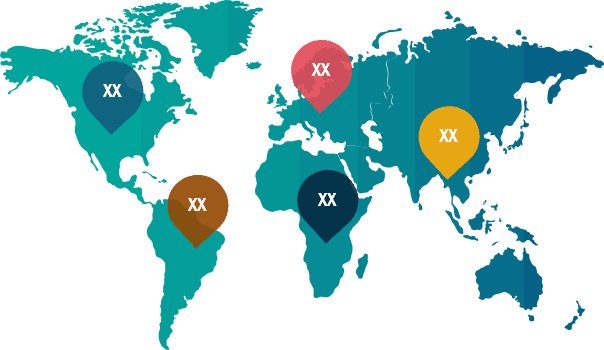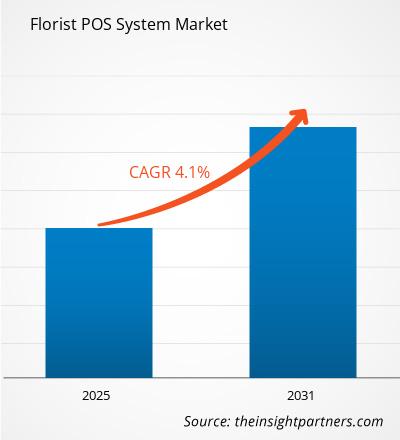预计2023 年至 2031 年期间,花店 POS系统市场复合年增长率将达到 4.1%。人工智能驱动的需求预测库存优化和非接触式支付选项可能仍是市场的主要趋势。
花店POS系统市场分析
- 随着越来越多的花店开始拥抱数字化,花店POS系统市场具有强劲的增长前景。许多中小型花店正在从传统收银机转向完整的POS系统,其中城市和大型企业是采用的先行者。
- 然而,一些花店仍然对成本或感知复杂性持谨慎态度。市场的主要趋势是基于云以及移动POS解决方案(与更广泛的零售趋势一致),总体而言,鉴于POS系统在花店领域的早期阶段,采用前景强劲,为进一步的市场渗透和增长留下了大量机会。
花店POS系统市场概览
- 花店POS市场是庞大的零售POS行业中的一小部分,主要针对花店的需求。这些解决方案提供易腐商品库存管理、定制订单处理和活动管理等功能
- 市场由花店POS专业供应商以及提供专注于花卉行业的模块的大型一般零售POS提供商组成。
- 由于竞争激烈以及鲜花销售数字化转型日益频繁,市场正在缓慢扩张。其主要竞争对手专注于基于云的解决方案、移动性以及与更广泛的电子商务解决方案的集成。
定制研究以满足您的需求
我们可以优化和定制标准产品无法满足的分析和范围。这种灵活性将帮助您获得业务规划和决策所需的准确信息。
花店POS系统市场:战略洞察

复合年增长率(2023 - 2031)4.1%- 2023 年市场规模
XX 百万美元 - 市场规模 2031
美元 XX 百万美元

市场动态
- 小型企业日益数字化,需要简化支付处理
- 采用基于云的POS解决方案
- 人工智能驱动的需求预测库存优化、非接触式支付选项
关键人物
- BloomNation 公司
- EposNow.com
- 花蛙
- 弗洛拉内克斯
- 花店用品
- 韩亚软件
- Hike POS 有限公司
- 光速
- Teleflora。
区域概况

- 北美
- 欧洲
- 亚太
- 南美洲和中美洲
- 中东和非洲
市场细分
 部署
部署- 本地和云
 企业规模
企业规模- 小型企业
- 中型企业
- 大型企业
- 示例 PDF 通过定性和定量分析展示了内容结构和信息的性质。
花店 POS 系统市场驱动因素和机遇
提高小企业数字化水平以利于市场发展
- 小型企业的数字化正在推动花店 POS 系统市场的发展,因为这些花店需要采用最新技术才能竞争和生存。其他行业小型企业内部运营的数字化将继续鼓励花店效仿,从传统的销售点收银机和手动文书工作升级到成熟的POS 系统
- 这些系统使花店能够实现自动库存跟踪、销售分析、客户管理和集成支付处理。数字化运营使花店能够简化工作流程、消除错误、做出数据驱动的决策并改善客户体验。
- 此外,随着鲜花行业的客户越来越期待数字化支付和针对性服务,花店也正在采用 POS 系统以在新零售领域中生存和保持相关性。
采用基于云的 POS 解决方案
- 基于云的 POS 解决方案为花店 POS 系统市场创造了巨大的机遇。此类解决方案具有位置独立性,可远程访问业务数据和运营,因此具有更高的灵活性、可扩展性和成本效益。
- 通过手机或任何具有互联网连接的设备管理业务运营,花店可以有效地监督其多个地点的业务运营或进行远程工作。
- 此外,与传统的本地解决方案相比,云 POS 解决方案通常需要较少的前期投资。因此,它们提供了更好的性价比,尤其是对于中小型花店而言。它们还会定期自动更新新功能和安全改进。例如,如果电子商务平台提供商提供新功能或改进,企业主只需获得正确的授权即可立即访问该功能。
- 此外,它们可以轻松地与其他常用的基于云的工具(如会计软件、电子商务平台、客户关系管理软件和其他在线工具)集成,从而使它们拥有一个有凝聚力和互联的商业生态系统。
花店 POS 系统市场报告细分分析
有助于得出花店 POS 系统市场分析的关键部分是部署和业务规模。
- 根据部署,花店 POS 系统市场分为本地和云端。
- 根据业务规模,花店 POS 系统市场分为小型企业、大型企业和中型企业。
花店 POS 系统市场份额按地区分析
- 花店 POS 系统市场报告包括对五个主要地理区域的详细分析,其中包括当前和历史市场规模以及 2021 年至 2031 年的预测,涵盖北美、欧洲、亚太地区 (APAC)、中东和非洲 (MEA) 以及南美洲和中美洲。
- 每个地区进一步细分为各个国家。本报告提供 18 个国家/地区的分析和预测,涵盖花店 POS 系统市场动态,例如影响区域市场的驱动因素、趋势和机会。
- 此外,该报告还涵盖 PEST 分析,其中涉及影响这些地区花店 POS 系统市场的主要因素的研究。
花店 POS 系统市场报告范围
| 报告属性 | 细节 |
|---|---|
| 2023 年的市场规模 | XX 百万美元 |
| 2031 年市场规模 | XX 百万美元 |
| 全球复合年增长率(2023 - 2031) | 4.1% |
| 史料 | 2021-2023 |
| 预测期 | 2024-2031 |
| 涵盖的领域 | 按部署
|
| 覆盖地区和国家 | 北美
|
| 市场领导者和主要公司简介 |
|
- 示例 PDF 通过定性和定量分析展示了内容结构和信息的性质。
花店 POS 系统市场新闻和最新发展
通过收集一手和二手研究的定性和定量数据来评估花店 POS 系统市场,其中包括重要的公司出版物、协会数据和数据库。以下列出了花店 POS 系统市场的一些发展情况:
- Hana Florist POS 与 Clearent 合作,为全美所有尊贵客户提供最先进的综合信用卡处理服务。(来源:Hana Software,新闻稿,2021 年 5 月)
花店 POS 系统市场报告覆盖范围和交付成果
“花店 POS 系统市场规模和预测(2021-2031 年)”报告对市场进行了详细分析,涵盖以下领域:
- 范围内涵盖的所有主要细分市场的全球、区域和国家/地区花店 POS 系统市场规模和预测
- 花店 POS 系统市场趋势以及市场动态,如驱动因素、限制因素和关键机会
- 详细的 PEST/波特五力分析和 SWOT 分析
- 花店 POS 系统市场分析,涵盖关键市场趋势、全球和、主要参与者、法规和最新市场发展
- 行业格局和竞争分析,涵盖市场集中度、热点图分析、知名参与者以及花店 POS 系统市场的最新发展
- 详细的公司简介
- 历史分析(2 年)、基准年、预测(7 年)及复合年增长率
- PEST 和 SWOT 分析
- 市场规模价值/数量 - 全球、区域、国家
- 行业和竞争格局
- Excel 数据集


- Fertilizer Additives Market
- Long Read Sequencing Market
- Health Economics and Outcome Research (HEOR) Services Market
- Bathroom Vanities Market
- 3D Mapping and Modelling Market
- Fixed-Base Operator Market
- Enzymatic DNA Synthesis Market
- Investor ESG Software Market
- Smart Locks Market
- Railway Braking System Market

Report Coverage
Revenue forecast, Company Analysis, Industry landscape, Growth factors, and Trends

Segment Covered
This text is related
to segments covered.

Regional Scope
North America, Europe, Asia Pacific, Middle East & Africa, South & Central America

Country Scope
This text is related
to country scope.
常见问题
The global Florist POS System market is expected to grow at a CAGR of 4.1% during the forecast period 2023 - 2031.
The increasing digitalization of small businesses and the need for streamlined payment processing are expected to drive the florist POS system market.
AI-powered demand forecasting inventory optimization and contactless payment options are likely to remain key trends in the market.
The leading players operating in the florist POS system market are BloomNation, Inc., EposNow.com, Floral Frog, FLORANEXT, FloristWare, Hana Software, Hike POS Pty Ltd, Lightspeed, and Teleflora.
The report can be delivered in PDF/PPT format; we can also share an Excel dataset based on the request.
Some of the customization options available based on request are additional 3–5 company profiles and country-specific analysis of 3–5 countries of your choice. Customizations are to be requested/discussed before making final order confirmation, as our team would review the same and check the feasibility.
Trends and growth analysis reports related to Technology, Media and Telecommunications : READ MORE..
The List of Companies
1. BloomNation, Inc.
2. EposNow.com
3. Floral Frog
4. FLORANEXT
5. FloristWare
6. Hana Software
7. Hike POS Pty Ltd
8. Lightspeed
9. Teleflora.
10. The Floral POS
The Insight Partners performs research in 4 major stages: Data Collection & Secondary Research, Primary Research, Data Analysis and Data Triangulation & Final Review.
- Data Collection and Secondary Research:
As a market research and consulting firm operating from a decade, we have published and advised several client across the globe. First step for any study will start with an assessment of currently available data and insights from existing reports. Further, historical and current market information is collected from Investor Presentations, Annual Reports, SEC Filings, etc., and other information related to company’s performance and market positioning are gathered from Paid Databases (Factiva, Hoovers, and Reuters) and various other publications available in public domain.
Several associations trade associates, technical forums, institutes, societies and organization are accessed to gain technical as well as market related insights through their publications such as research papers, blogs and press releases related to the studies are referred to get cues about the market. Further, white papers, journals, magazines, and other news articles published in last 3 years are scrutinized and analyzed to understand the current market trends.
- Primary Research:
The primarily interview analysis comprise of data obtained from industry participants interview and answers to survey questions gathered by in-house primary team.
For primary research, interviews are conducted with industry experts/CEOs/Marketing Managers/VPs/Subject Matter Experts from both demand and supply side to get a 360-degree view of the market. The primary team conducts several interviews based on the complexity of the markets to understand the various market trends and dynamics which makes research more credible and precise.
A typical research interview fulfils the following functions:
- Provides first-hand information on the market size, market trends, growth trends, competitive landscape, and outlook
- Validates and strengthens in-house secondary research findings
- Develops the analysis team’s expertise and market understanding
Primary research involves email interactions and telephone interviews for each market, category, segment, and sub-segment across geographies. The participants who typically take part in such a process include, but are not limited to:
- Industry participants: VPs, business development managers, market intelligence managers and national sales managers
- Outside experts: Valuation experts, research analysts and key opinion leaders specializing in the electronics and semiconductor industry.
Below is the breakup of our primary respondents by company, designation, and region:

Once we receive the confirmation from primary research sources or primary respondents, we finalize the base year market estimation and forecast the data as per the macroeconomic and microeconomic factors assessed during data collection.
- Data Analysis:
Once data is validated through both secondary as well as primary respondents, we finalize the market estimations by hypothesis formulation and factor analysis at regional and country level.
- Macro-Economic Factor Analysis:
We analyse macroeconomic indicators such the gross domestic product (GDP), increase in the demand for goods and services across industries, technological advancement, regional economic growth, governmental policies, the influence of COVID-19, PEST analysis, and other aspects. This analysis aids in setting benchmarks for various nations/regions and approximating market splits. Additionally, the general trend of the aforementioned components aid in determining the market's development possibilities.
- Country Level Data:
Various factors that are especially aligned to the country are taken into account to determine the market size for a certain area and country, including the presence of vendors, such as headquarters and offices, the country's GDP, demand patterns, and industry growth. To comprehend the market dynamics for the nation, a number of growth variables, inhibitors, application areas, and current market trends are researched. The aforementioned elements aid in determining the country's overall market's growth potential.
- Company Profile:
The “Table of Contents” is formulated by listing and analyzing more than 25 - 30 companies operating in the market ecosystem across geographies. However, we profile only 10 companies as a standard practice in our syndicate reports. These 10 companies comprise leading, emerging, and regional players. Nonetheless, our analysis is not restricted to the 10 listed companies, we also analyze other companies present in the market to develop a holistic view and understand the prevailing trends. The “Company Profiles” section in the report covers key facts, business description, products & services, financial information, SWOT analysis, and key developments. The financial information presented is extracted from the annual reports and official documents of the publicly listed companies. Upon collecting the information for the sections of respective companies, we verify them via various primary sources and then compile the data in respective company profiles. The company level information helps us in deriving the base number as well as in forecasting the market size.
- Developing Base Number:
Aggregation of sales statistics (2020-2022) and macro-economic factor, and other secondary and primary research insights are utilized to arrive at base number and related market shares for 2022. The data gaps are identified in this step and relevant market data is analyzed, collected from paid primary interviews or databases. On finalizing the base year market size, forecasts are developed on the basis of macro-economic, industry and market growth factors and company level analysis.
- Data Triangulation and Final Review:
The market findings and base year market size calculations are validated from supply as well as demand side. Demand side validations are based on macro-economic factor analysis and benchmarks for respective regions and countries. In case of supply side validations, revenues of major companies are estimated (in case not available) based on industry benchmark, approximate number of employees, product portfolio, and primary interviews revenues are gathered. Further revenue from target product/service segment is assessed to avoid overshooting of market statistics. In case of heavy deviations between supply and demand side values, all thes steps are repeated to achieve synchronization.
We follow an iterative model, wherein we share our research findings with Subject Matter Experts (SME’s) and Key Opinion Leaders (KOLs) until consensus view of the market is not formulated – this model negates any drastic deviation in the opinions of experts. Only validated and universally acceptable research findings are quoted in our reports.
We have important check points that we use to validate our research findings – which we call – data triangulation, where we validate the information, we generate from secondary sources with primary interviews and then we re-validate with our internal data bases and Subject matter experts. This comprehensive model enables us to deliver high quality, reliable data in shortest possible time.

 获取此报告的免费样本
获取此报告的免费样本